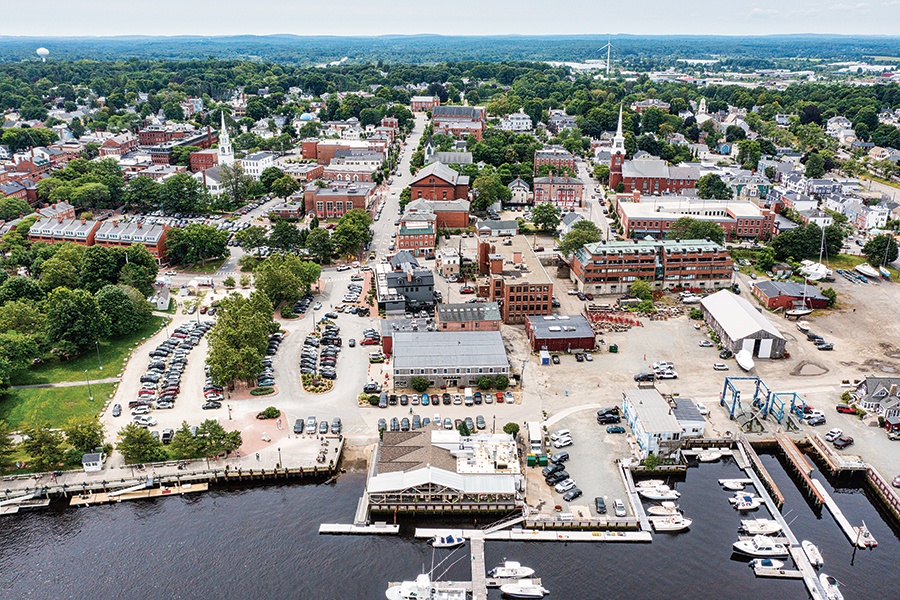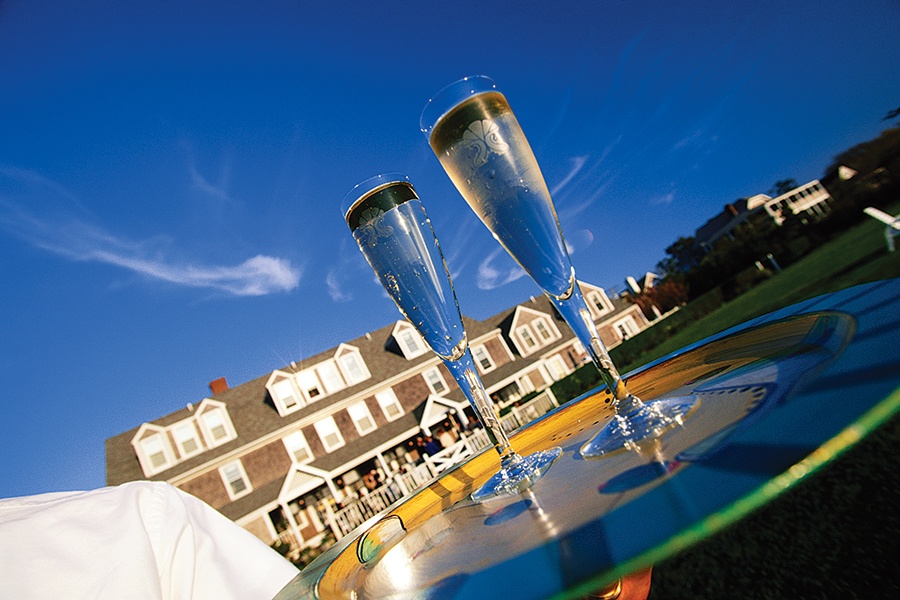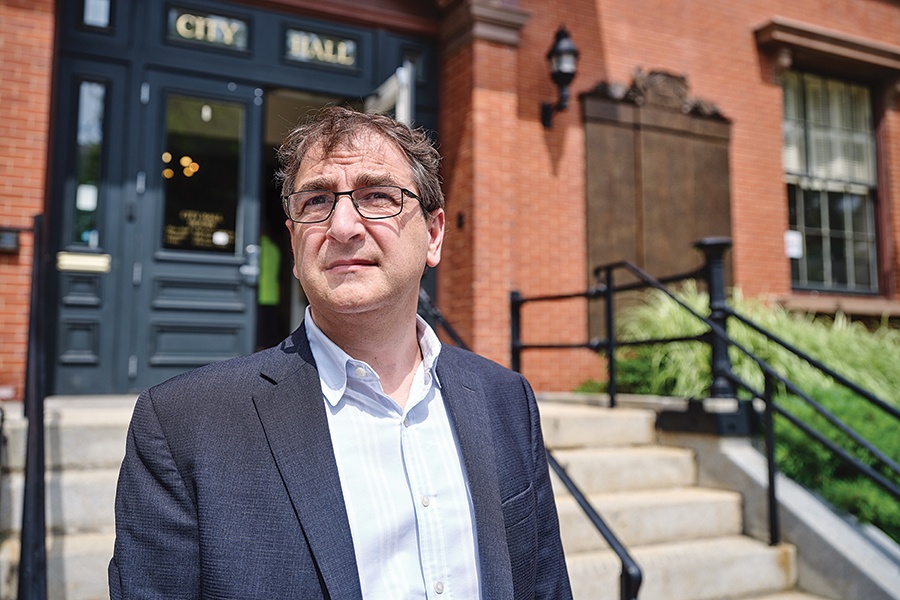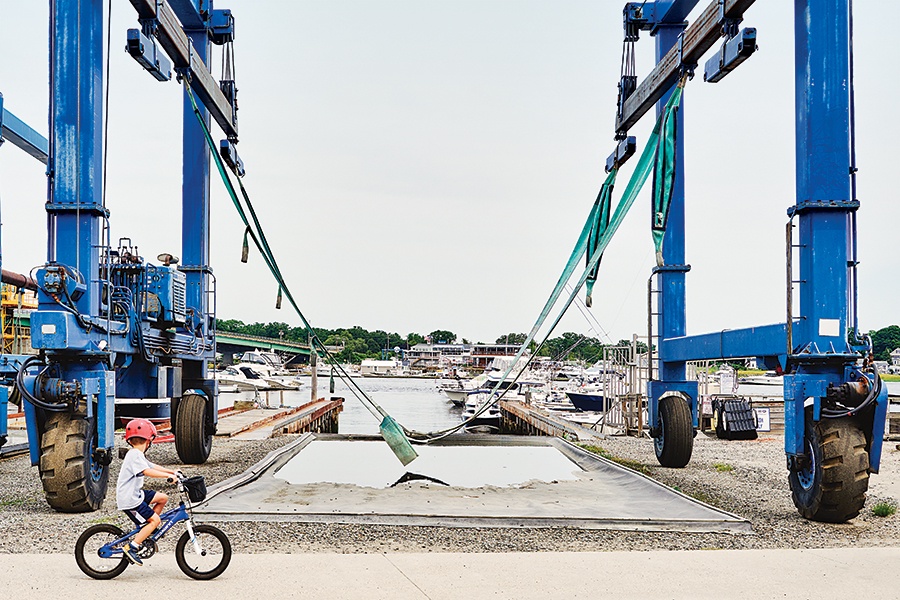Don’t Nantucket My Newburyport
Famed developer Steve Karp helped transform Nantucket into a glitzy island paradise. Then he set his sights on the seaside jewel of the North Shore. Turns out the townspeople had other plans.

Newburyport’s waterfront has become something of a white elephant for famed Nantucket developer Steve Karp, as locals have blocked his plans to build up the property he owns there at every turn. / Photo by Michael Prince
Steve Karp, as the story goes, was driving with his wife and children out to Great Point, Nantucket, that wild and protected tip of the island that sits between two bodies of water in the shadow of a lighthouse. As they passed through the village of Wauwinet and by the road leading to a dilapidated historical inn, Karp fondly recalled the many times he had stopped there for dinner and drinks over the years.
Karp had been in love with Nantucket since he started going to the island as a Boston University student. Now, many years later, he was a wildly successful retail real estate developer who had built one of the Northeast’s first enclosed malls in Danvers, and then many more since. He amassed a fortune along the way, some of which he used to buy an elegant home on Nantucket, where he and his family summered.
As the Karps drove past the inn, they engaged in their running joke, just as they always did when they were out on this end of the island: Maybe Dad should buy the old place, fix it up, and they could run it as a family business. At one point, they even discussed how Karp’s mother would be the cook, his father-in-law would run the tennis courts, and his mother-in-law would greet the guests as they rolled into the lobby.
By the late 1980s, Karp had made good on the joke. But far from the quaint family business he and his wife once envisioned, the acquisition of the Wauwinet inn was just the toehold of an empire on Nantucket that Karp was about to build. After buying and poshing up four hotels, he dropped $75 million in 2005 on some 50 properties. Almost overnight, he became downtown Nantucket’s largest property owner, and the island’s highest-paying taxpayer.
Karp wasn’t content to practically own the place, though. He wanted to remake the island in his vision, which was of a decidedly more exclusive, more profitable destination. There were plenty of beach towns in New England where people could spend the day, buy an ice cream and a T-shirt, and head back home. Karp didn’t believe Nantucket should be one of them.
Fast-forward to today and, thanks in large part to Karp and his company, New England Development Corp., it isn’t. From early spring through late fall, Nantucket’s downtown cobblestoned streets are teeming with visitors who come to sail, shop, spend lots of cash, and stay at least a night or two. Hotel rooms can easily cost $1,000 a night, which doesn’t sway most of the 400,000 tourists who come each year. In 2018, the real estate market hit $1.12 billion. It is one of the most expensive places to vacation on Earth.
Around the same time he bought dozens of properties, Karp trained his sights—and his investments—on his next project: Newburyport. Similar to Nantucket, he’d fallen in love with the place after spending time there with his family, exploring the quaint downtown streets, noticing the easy MBTA access, and enjoying the nearby protected areas where visitors could immerse themselves in nature. He started buying up real estate, and Newburyporters began to wonder if Karp would work his magic on their seaside town, just as he had on Nantucket, transforming it from a North Shore gem where Bostonians might drop in for a stroll and maybe a modestly priced souvenir into a swanky international tourist destination with great restaurants, high-end shops, and a fancy hotel, all alongside beautiful beaches just a quick 50 minutes north of the city on I-95.
Karp’s development of Nantucket had been relatively seamless, and observers had no reason to think it would be any different in Newburyport. After all, there were plenty of similarities, from the charming downtown and waterfront to the focus on historic preservation and honoring the area’s seafaring history. There were beaches and protected areas. And there were similarities in Karp’s acquisition trajectory as well: As on Nantucket, he quickly became the owner of the vast majority of the commercial real estate downtown and Newburyport’s biggest landlord.
That’s where the parallels end. Karp’s dreams of developing a 5-acre swath of a largely unused waterfront property on the Merrimack River—which has been the crown jewel of his Newburyport portfolio and the centerpiece around which he’s built his vision for the city—have been blocked at every turn by locals and city officials who say they’re defending their town’s history and character. As a result, remarkably little progress has been made in converting Newburyport into the next Nantucket, or even simply making it more upscale. Karp may be a billionaire and one of the most powerful real estate developers in the country, yet it appears he had little idea what he was up against in Newburyport. And now, after his latest moves in the city—which some locals consider akin to a declaration of war—it seems that Newburyporters didn’t fully understand what they were up against, either.

The Wauwinet, one of four hotels famed developer Steve Karp purchased on Nantucket before he bought roughly 50 retail properties and became the biggest property owner downtown and the island’s largest taxpayer. / Photo via Getty Images

Famed developer Steve Karp. / Photo © Bruce R. Bennett/The Palm Beach Post/Zumapress.com
Three years after Karp began acquiring properties in Newburyport, the community finally got to meet the man with the fate of their town in his hands. On a cloudy March evening in 2008, the parking lot of Nock Middle School was overflowing with cars, and a long line of residents snaked down the corridor into a standing-room-only auditorium. Karp stood at the entrance, dapper in a dark suit and red power tie, shaking hands with residents and marveling at the sheer number of people who had come out to hear him speak. “Do you usually get crowds like this?” he said with a smile to an attendee.
After greeting the crowd, Karp gave an upbeat, hourlong presentation that included his future plan for the city’s waterfront—the most anxiety-producing issue for locals—which is known as Waterfront West. Since he hadn’t yet presented a formal proposal, it was light on details. Instead, he said he was simply there to assuage any fears about what he had in store for the town. “You’re the kings and this is your castle,” he told the residents assembled before him. “We are invaders to your castle” who need to be invited in.
As it turns out, getting invited into Newburyport isn’t so easy. Even in a region known for being unwelcoming to outsiders, Newburyporters can be particularly circumspect. To some, it isn’t enough to be born here to be considered “from” here. Take Jared Eigerman, for instance. The president of the city council, he was born here and considers it home. But his parents weren’t born here, which to many makes him an outsider. “Newburyporters like to trace back many generations,” Eigerman says. Nevertheless, the Harvard-educated city planner and attorney has emerged as one of the fiercest defenders of the city’s history and character. His vision for Newburyport’s future is to keep things pretty much just as they are. It’s a position that has made him the nemesis of many business owners, particularly Karp.
It took Karp and New England Development 11 years after purchasing the waterfront property to actually submit a formal proposal, but it didn’t take nearly as long for the company to garner criticism over the way it was managing its share of the city’s downtown commercial real estate, of which it controls the vast majority. “I don’t think Newburyporters want one organization that owns and controls everything, and therefore has hegemonic control over rents, decides which restaurants come in, which don’t, which retailers come in, which don’t,” Eigerman says. “But that’s our system.”
The increasing rents for local businesses have been an issue, too. Also a bone of contention is that Karp uses a model to charge rents that is based on a flat fee in addition to a percentage of what tenants earn. It is not uncommon in the retail industry but was new for Newburyport businesses. The high cost of rent isn’t necessarily conducive to the kinds of businesses Eigerman thinks many Newburyporters would like to see downtown—namely, stores that carry essential, everyday necessities, as well as moderately priced neighborhood restaurants. Eigerman’s interpretation of NED’s vision for Newburyport is that of an outdoor mall: a shopping center that looks like a quaint New England town, rather than a real New England town where people actually live.
In fact, though, the downtown scene isn’t what most Newburyporters are worked up about, and the mayor and the city council don’t have any say in how NED runs its rental properties anyway. The real battle between the locals and Karp is the waterfront. That is where the city can, through its zoning and historic-preservation ordinances, wield significant power over Karp’s desires. And it has done so to keep him from fulfilling his sleek, modern, and upscale vision for a new Newburyport.

City Council President Jared Eigerman, a native Newburyporter, land-use lawyer, and city planner, has long defended the city’s history and character— and that has caused him to clash with Karp.
In December 2016, after eight years of anticipation since the first big meeting—and no small amount of anxiety among the locals—Karp finally unveiled his proposal for the waterfront. In an informal presentation to Mayor Donna Holaday, the city council, municipal planners, and nearly 150 residents, Scott Kelley, a New England Development VP, laid out a plan that included a 20- to 25-unit residential building with as many as 120 more units to follow over the next decade, plus a hotel with about 80 rooms and 6,500 square feet of retail space. A polished marina made room for about 130 boats. In renderings, the buildings were angular, urban, and very, very tall—and, most in the room thought, not at all Newburyport, where the skyline’s point of pride is the Unitarian Universalist church steeple. “Why so big?” asked one resident who attended the meeting.
The proposal immediately divided the town. On one side stood the people who wanted, as their lawn signs read, to “Save Our Waterfront.” In a poll that ran in Newburyport’s Daily News, 39 percent said no thanks—they wanted to leave the waterfront as is. An additional 16 percent were concerned the project would block water views or access. On the other side were those who saw the appeal, mostly via rising property values, in letting a big, monied developer clean up what they considered an underused stretch of town.
Eigerman and other council members across several committees and boards charged with determining the fate of the proposal and ensuring that it would not alter or threaten Newburyport’s character agreed that the height of the buildings represented nothing less than a transformation of the cityscape. City planners delivered their verdict to New England Development: To greenlight this particular plan would require significant zoning changes, including to maximum building heights, minimum lot frontages, and open space requirements. It wasn’t going to happen.
Eight months later, NED presented a revised plan that reduced the height of some of the buildings and created more public space in the form of two small parks. The plan also included retaining part of the working marina. The look and feel was reimagined to be more Newburyport—with brick-and-wood massing, wooden shutters, and other features made to fit in with the town’s historical buildings—but the locals still weren’t convinced. “I hate it,” said one resident who attended the presentation. “I think that having any sensibility of Newburyport lets you know we want an open waterfront.” The city sent NED back to the drawing board.
On and on it went. Over the next few years, an ad hoc committee was formed between the planning board and the city council. An urban-design consultant was brought in. No one could agree on anything. In August 2018, Karp presented another version of the proposal that reduced the square footage, increased open space, and included a 100-room hotel. Most of the buildings, however, were still too tall at five stories, creating a “sterile, self-contained wall-city,” as one resident put it, adding, “Why not put up a drawbridge and a moat?”
It appeared the two sides were at an impasse: The city wouldn’t budge on the zoning regarding building height, and NED wouldn’t budge on what it said were the number of residential units it needed in order to make the project viable. Owning most of downtown was a moneymaker, surely, but the real interest for a developer of Karp’s caliber, many locals assumed, was selling high-end waterfront condos to boat owners.
At one of the last community meetings, in 2019, town members stood up, one by one, to take the floor. The proposed development was too dense, some said. They hated the design, others said. This went on for hours until close to 60 people had given the proposal a vehement thumbs-down. At the end of the evening, Holaday stood up and addressed NED’s representatives. “Gentlemen, this is where we are,” she told them. “There is no support for this current design.”
After that, Holaday began to hear rumblings from NED that it might not be able to include a hotel, which was the one thing the city desperately wanted out of the project. Currently, Newburyport has only a small handful of inns, none of which has a restaurant, a conference center, or a place, as Holaday put it, for high schoolers to hold their proms. A hotel would be better for the city’s restauranters and retailers, and for the residents who had nowhere to put their visiting families. “They told us it’s not profitable enough,” Holaday says. Still, she wasn’t caving on the height of the buildings—five stories was too high. “I can’t stand up there and support a design that no one in the city likes,” Holaday said.
At the time, it looked as though the town’s relationship with Karp couldn’t get any worse. Then, this past summer, the developer seemed to forget about the invitation he’d requested from Newburyporters, and instead, in ways large and small, he stormed the gates.

A shot from the largely undeveloped waterfront on the Merrimack River in Newburyport. / Photo by Michael Prince

Steve Karp’s plans to develop a 5-acre property he purchased here have stymied by the city council and residents of Newburyport. / Photo by Michael Prince
On a chilly February day, Bruce Vogel was behind the counter at Plum Island Coffee Roasters, the shop he owned that sat smack dab in the middle of Karp’s Waterfront West land. Locals loved the Roasters, as they called it, in large part because it felt so authentically Newburyport, tucked in the back of a dusty working boatyard in the shadow of half-million-dollar boats along a path that connected one part of a waterfront boardwalk to the next. The Roasters was also a place that forged connections, as Vogel made laptoppers and other loitering types share tables, which he says people bristled at but also secretly loved.
It was the middle of the morning rush, with people bundled in down parkas standing outside the pickup window Vogel had installed during COVID or waiting to get inside to place their orders, when Chris Skiba, the general manager of NED’s local office in town, walked in the door. He went over to Vogel, who is also a city council member, and handed him a piece of paper. “You have two weeks,” Vogel recalls him saying. Then Skiba turned and walked back out the way he’d come in.
According to the notice, Vogel actually had 45 days to vacate his storefront, which he took, plus a month more. As days turned to weeks, the kerfuffle became something of a small-town standoff: Local headlines declared that “Coffee Roasters Owner Disregards Deadline, Vows to Stay Open,” while an online petition gathered more than 15,000 signatures opposing PICR’s eviction. Reports that Luchos, a Mexican cantina owned by New Hampshire–based restauranters the Fleury Group, would take the Roasters’ place inspired a Newburyport Daily News comic that Vogel cut out of the paper, framed, and hung on the wall: “We don’t want no tacos.” Residents were clearly behind Vogel and his beloved café. But none of it seemed to matter. In mid-April, PICR served its last latte, and what little goodwill locals had for Karp quickly fizzled away.
Vogel says it’s hard not to take the end of his tenancy personally, considering that 2020 had been his best year yet, despite COVID, with more than $600,000 in sales—8 percent of which went directly to New England Development as part of the rent-percentage model. What’s more, the cantina isn’t set to open until 2022 and, as of early August, no work had been done on the building.
He isn’t the only one taking it personally. Many people in Newburyport saw NED’s closing of Plum Island Coffee Roasters as an affront to the town itself, embodying what they feel is the company’s disregard for locals. It didn’t matter to NED that the Roasters was a favorite meeting place and de facto town center. Many people thought NED targeted the shop as a way to send a message, perhaps even to the mayor and city council, that it was in charge. (In an interview over email, Skiba said that “Plum Island Coffee Roasters was not evicted from their site; their lease expired in early 2019 and the coffee shop’s relationship with Newburyport Development was held over as a month-to-month tenant agreement for more than two years.”)
The closure of the café may have been an insult to the city, but NED threw down the gauntlet when it presented its most recent proposal for the waterfront. Karp’s July meeting with Holaday and Port took place on a sticky day, and the floor-unit A/C in Holaday’s office at City Hall was humming in the background as it worked overtime to keep everyone cool—a tall order once Karp and his team began describing their idea.
Karp had done a 180. Gone were the luxury condos. Gone was the hotel the town so desired. In its place, he explained that he had brought in real estate company AvalonBay Communities to partner on the development of the site under the state’s Chapter 40B law, which gives them the chance to circumvent zoning laws by including 25 percent affordable housing. Two five-story buildings would contain a total of 230 rental units.
Holaday isn’t opposed to affordable housing, but says the proposal was appalling for other reasons. “They had a picture from across the river, and you could barely see the steeple. It wrecks our skyline. I was not pleased at all. I just said, again, too tall. And where’s the hotel?” she says. “I feel like I wasted months of my life in meetings with them and then all of a sudden, everything just got blown up. They know that our first priority was a hotel on that site. Theirs was condos. And since they can’t get what they want, I don’t think they’re going to let us have what we want.” Vogel puts it more bluntly: “It’s just more bullying.” (In the email interview, Skiba confirmed it had partnered with AvalonBay to develop the site, but that it was premature to comment further.)
The irony, Eigerman says, is that if NED wanted to build 100 percent affordable housing at that location, the city would love it. But not at five stories tall, blocking the views of the steeple and creating a self-contained wall-city. He doesn’t think Karp is driven by the affordable-housing aspect, considering it wasn’t in his original plans, but by the 40B provision, which gives him a powerful weapon to wield against the zoning board. That’s because, if the board refuses to grant the exceptions NED would need for the project, the developer can use the 40B status to petition the state government for approval, alleging the town is using its zoning laws to block affordable housing. If Newburyport lost at the state level, the matter could end up in court, resulting in a lengthy and costly legal battle. For his part, Eigerman says the city isn’t intimidated, nor will it back down. “This is not a city where we just roll over and give up,” he says.
Some people in town speculate that this proposal may be Karp’s last, and that if he fails, he’ll try to offload the waterfront property and maybe even his properties downtown. That potential scenario has begun to cause a surprising reaction among some in town: worry. What if he turns the project over to AvalonBay, which is known for big, boxy developments? Who else might he sell it to, and would they be worse? For her part, Nancy Batista-Caswell, owner of Newburyport’s most upscale restaurant, Brine, appreciates her landlord, Steve Karp. “I look at it like, it’s the devil you know,” she says. “He didn’t close up on any retailer through COVID. Everybody’s coming out of it on the other side. I worry that if we were to push out somebody like him, you just never know what you’ll get in return.”
Maybe the town would get someone who would agree to build a hotel and keep the roofline low. At the same time, the developer who would buy the waterfront property that’s become a white elephant for Karp might not convert it into anything half as lovely as Karp’s White Elephant resort on Nantucket. After all, Batista-Caswell wonders, “What if we wind up with, like, a Hampton Inn. What if we’re like, ‘Wait, what happened here?’”


